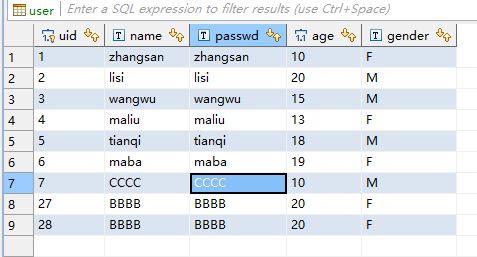这两个对象的区别:
1.Statement它更适合执行不同sql的批处理,它没有提供预处理功能,性能比较低。
2.PreparedStatement它适合执行相同的批处理,它提供了预处理功能,属性比较高。
/**
* @param args
* @throws SQLException
* @throws ClassNotFoundException
*/
public static void main(String[] args) throws ClassNotFoundException,
SQLException {
// 定义sql 语句
String sql1 = "create table person(id int,name varchar(20))";
String sql2 = "insert into person values(1,'tom')";
String sql3 = "insert into person values(2,'fox')";
String sql4 = "insert into person values(3,'tony')";
String sql5 = "update person set name='张三' where id=1";
String sql6 = "delete from person where id=3";
Connection conn = jdbcUtils. getConnection();
Statement st = conn.createStatement();
// 添加批处理sql
st.addBatch(sql1);
st.addBatch(sql2);
st.addBatch(sql3);
st.addBatch(sql4);
st.addBatch(sql5);
st.addBatch(sql6);
// 执行批处理sql
st.executeBatch();
st.clearBatch();
st.close();
conn.close();
}
使用版本高一点的 jdbc的jar包时加入参数可开启缓存在url中加参数:
?useServerPrepStmts=true&cachePrepStmts=true&rewriteBatchedStatements=true
/**
* @param args
* @throws SQLException
* @throws ClassNotFoundException
*/
public static void main(String[] args) throws ClassNotFoundException,
SQLException {
String sqlString = "insert into person values(?,?)";
Connection conn = jdbcUtils. getConnection();
PreparedStatement pst = conn.prepareStatement(sqlString);
long l = System. currentTimeMillis();
for ( int i = 0; i < 10000; i++) {
pst.setInt(1, i);
pst.setString(2, "name" + i);
pst.addBatch();
if (i % 1000 == 0) {
pst.executeBatch();
pst.clearBatch(); // 清空缓存
}
}
pst.executeBatch();
pst.close();
conn.close();
System. out.println(System. currentTimeMillis() - l);
}
方法:
public static Connection getConnection(){
try {
Class.forName( "com.mysql.jdbc.Driver");
ct = DriverManager.getConnection( "jdbc:mysql://127.0.0.1:3306/test","squirrel","xiaoyang");
} catch (Exception e) {
e.printStackTrace();
}
return ct;
}
/**释放数据库链接资源:注意数据库资源关闭的顺序*/
public static void closeConnection(){
try { //注意关闭数据库资源的先后顺序
if(rs!=null){
rs.close();
} if(ps!=null){
ps.close();
} if(ct!=null){
ct.close();
}
} catch (SQLException e) {
e.printStackTrace();
}
}
测试方法:
/**
* PreparedStatement批量执行sql
*/
public static void excuteBatchInsertDatabase(){
ct=getConnection();
try {
ct.setAutoCommit( false);
ps=ct.prepareStatement( "insert into user(name,passwd,age,gender) values(?,?,?,?)");
ps.setString( 1, "BBBB");
ps.setString( 2, "BBBB");
ps.setInt( 3, 20);
ps.setString( 4, "F");
ps.addBatch();
ps.setString( 1, "BBBB");
ps.setString( 2, "BBBB");
ps.setInt( 3, 20);
ps.setString( 4, "F");
ps.addBatch();
/**
* 等价于sql语句:
* insert into user(name,passwd,age,gender) values
* ("BBBB","BBBB",20,'F'),
* ("BBBB","BBBB",20,'F');
*/
ps.executeBatch(); //批量执行sql,避免因此单次的insert操作建立多个Connection浪费资源
ct.commit();
} catch (Exception e) {
e.printStackTrace();
try {
ct.rollback();
} catch (SQLException e1) {
e1.printStackTrace();
}
} finally{
closeConnection();
}
}
执行excuteBatchInsertDatabase()方法数据库记录:

数据库数据记录表明:sql语句批量执行成功
注意:
批量查询最好交由一个事务组控制,如果出现操作异常可以进行事务回滚,不至于造成部分数据更新部分数据更新失败的尴尬局面,避免你脏数据污染数据库
由于 PreparedStatement 对象已预编译过,所以其执行速度要快于 Statement 对象。因此,多次执行的 SQL 语句经常创建为 PreparedStatement 对象,以提高效率
Statement用于执行静态的sql语句
由于PreparedStatement创建对象消耗资源比较高,所以只执行 一次的sql语句,不使用PreparedStatement
主要目的减少执行计划次数,防止sql注入
jdbc 元数据 meta ,ResultSet.xxx
Mysql jdbc 关闭自动提交事务 可提升性能 conn.setAutoCommit(false) ,
归还conn时 须提前设置为.setAutoCommit(true)
rollback()回滚
批量处理:一次向数据库发送多个SQL语句时,可以减少通信开销,从而提高性能。














